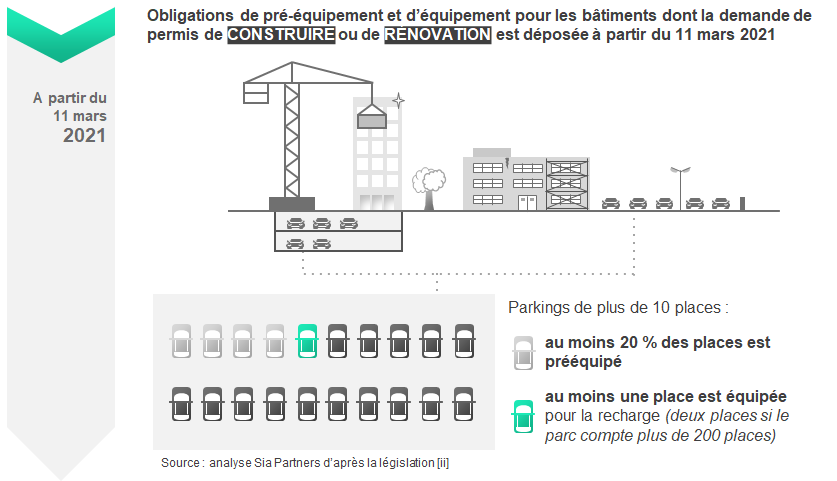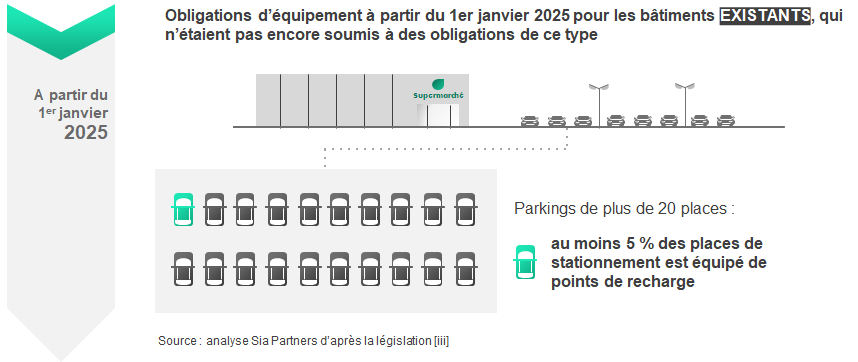Opportunities for waste management from solar and…

Changes to the Construction Code were passed at the end of 2019. They include the obligations to pre-equip and equip parking lots in electric vehicle charging infrastructure (EVCI) are reinforced by 2021 for new buildings, and by 2025 for existing buildings.

Ces évolutions réglementaires, combinées à une forte croissance du marché des véhicules électriques et hybrides et à un accroissement du besoin de recharge des usagers, invitent à se saisir dès aujourd’hui du sujet de l’installation de bornes de recharge dans les parcs de stationnement. Les acteurs concernés, ceux du retail notamment, doivent réfléchir à leur stratégie afin d’exploiter les différentes opportunités commerciales qui en découlent.
Après un éclairage sur ces nouvelles obligations réglementaires s’appliquant aux bâtiments tertiaires et commerciaux [i], cet article propose aux acteurs du retail une réflexion sur la stratégie globale à élaborer et à mettre en œuvre autour du service de recharge, ainsi que sur les opportunités à saisir.
Concernant l’installation d’IRVE, la LOM distingue et définit les notions de pré-équipement (faciliter la mise à disposition de l’électricité au futur point de charge) et d'équipement (installation effective des IRVE). Cette distinction permet à la fois de graduer les obligations des entreprises et d’anticiper les besoins futurs en permettant d’y répondre progressivement. Le pré-équipement permet ainsi à l’offre de recharge globale de suivre la hausse du nombre de véhicules électriques mis à la route en France.
Depuis mars 2021, les obligations de pré-équipement auxquelles sont soumis les bâtiments construits et rénovés sont plus contraignantes, et de nouvelles obligations d’équipement en bornes de recharge s’y ajoutent. Les bâtiments existants seront à leur tour soumis à des obligations d’équipement en bornes de recharge à partir de janvier 2025. L'illustration ci-dessous reprend les différentes obligations s’appliquant progressivement aux bâtiments neufs et existants.


Les projets d’installation de bornes de recharge sur parkings existants peuvent prendre plusieurs mois pour être menés à bien, particulièrement dans le cas des grands parcs de stationnement. L’ensemble des acteurs exploitant des bâtiments commerciaux doit donc se mobilisé dès aujourd’hui pour s’assurer d’être en conformité avec la LOM.
Par ailleurs, de nombreux programmes de subventions nationaux et régionaux existent pour soutenir et encourager les acteurs qui s'engagent dès aujourd'hui dans de tels projets. Le programme ADVENIR [iv], dont les montants des subventions sont particulièrement attractifs sur l’année 2021, permet notamment aux propriétaires de parkings privés non résidentiels de bénéficier d’aides allant jusqu’à 9 000 € par point de charge (pour l’installation d’IRVE ouvertes au public d'une puissance de 50 kW DC).
Afin de ne pas les pénaliser, les petites et moyennes entreprises [v] ne sont pas soumises aux nouvelles obligations [vi]. Pour les autres acteurs, certaines situations peuvent entraîner des exemptions de façon à ne pas imposer à l’entreprise des projets trop coûteux : parking en dessous d’une certaine taille, montant des travaux IRVE supérieur à un certain seuil, parking non inclus dans le périmètre de la rénovation, etc. [vii]
L’installation de bornes de recharge relève d’obligations réglementaires, mais répond également à une demande croissante des usagers des bâtiments commerciaux : les clients majoritairement, et dans une moindre mesure les employés qui y travaillent. Pour les centres commerciaux, les cinémas ou la grande distribution, l’installation de bornes permet de proposer un service de recharge à part entière, qui pourra venir compléter une gamme de services déjà existante. En intégrant l’installation de bornes de recharge à une stratégie plus globale, les entreprises peuvent saisir de nouvelles opportunités commerciales en fonction de leurs objectifs :

Afin de garantir l’optimisation des investissements et de maximiser leur rentabilité, les entreprises doivent tout d’abord déterminer les objectifs qu’elles visent avec un service de recharge de véhicules électriques, afin de construire une solution de recharge en cohérence avec leur stratégie.
La première étape consiste à bien comprendre les obligations réglementaires qui s’appliquent, mais également à quantifier et à qualifier la demande en recharge sur la durée, pour les différents utilisateurs. Contrairement au plein d’essence d’un véhicule thermique, la recharge d’un véhicule électrique ne requiert par la présence de l’utilisateur, et les rotations de véhicules sont moins fréquentes. Ainsi, des bornes de recharge rapides de 50 kW vont permettre au véhicule de récupérer près de 150 km d’autonomie en 30 minutes. Sur une borne de 7,4 kW, le même temps de charge permettra de récupérer environ 25 km d’autonomie. Le choix des bornes, ou du mix de bornes à installer dépendra donc de l’objectif visé : fournir un service de recharge rapide à des utilisateurs qui viendront spécifiquement pour en bénéficier (modèle “station service”), ou bien fournir aux clients habituels un service additionnel dont ils pourront profiter pendant leur présence sur le site. Dans les deux cas, le temps de la recharge peut être mis à profit pour proposer à l’utilisateur des services à proximité.
L’investissement de départ et les retombées économiques seront plus ou moins importants en fonction :
L’entreprise devra ensuite définir les modalités du nouveau service de recharge qu’elle propose, en fonction de ses objectifs :

Afin de rendre le service de recharge plus qualitatif, les entreprises pourront proposer à leurs clients des services affinitaires : information sur la disponibilité des bornes, réservation à distance et suivi de la recharge, etc. Pour aller plus loin, l’utilisation des données fournies par les bornes (heure d’arrivée du client, durée de charge restante, modèle du véhicule, etc.) pourraient également permettre de proposer des services personnalisés et d’approfondir la relation client : suggestion d’activité en fonction du temps de recharge anticipé, promotions ciblées en fonction de l’heure d’arrivée, suggestions sur mesures en analysant le profil du client, etc. De nombreuses opportunités peuvent être étudiées en fonction des données récupérées et des activités de l’entreprise.
Le renforcement des obligations réglementaires est l’occasion pour les entreprises du retail d’appréhender l’installation de bornes de recharge comme faisant partie intégrante de leur stratégie globale à long terme. Accorder des moyens à la réflexion autour de ce projet et à sa mise en œuvre est essentiel pour le rentabiliser. Sia Partners accompagne les entreprises dans ces transformations.
[i] Les bâtiments résidentiels et mixtes sont par ailleurs soumis à d'autres obligations d’équipement, qui ne sont pas détaillées ici.
[ii] Article L111-3-4 du code de la construction. Plus d’informations sur les caractéristiques du pré-équipement : http://www.avere-france.org/Site/Article/?article_id=7945&from_espace_adherent=0
[iii] Article L111-3-5 du code de la construction
[iv] Programme ADVENIR : financement de points de recharge privés ou ouverts au public par les CEE, Advenir, 2020
[v] Entreprises qui occupent moins de 250 personnes et dont le chiffre d'affaires annuel n'excède pas 50 millions d'euros ou dont le total du bilan annuel n'excède pas 43 millions d'euros (définition de la Commission européenne)
[vi] Article L111-3-6 du code de la construction
[vii] Articles L111-3-4 et L111-3-5 du code de la construction